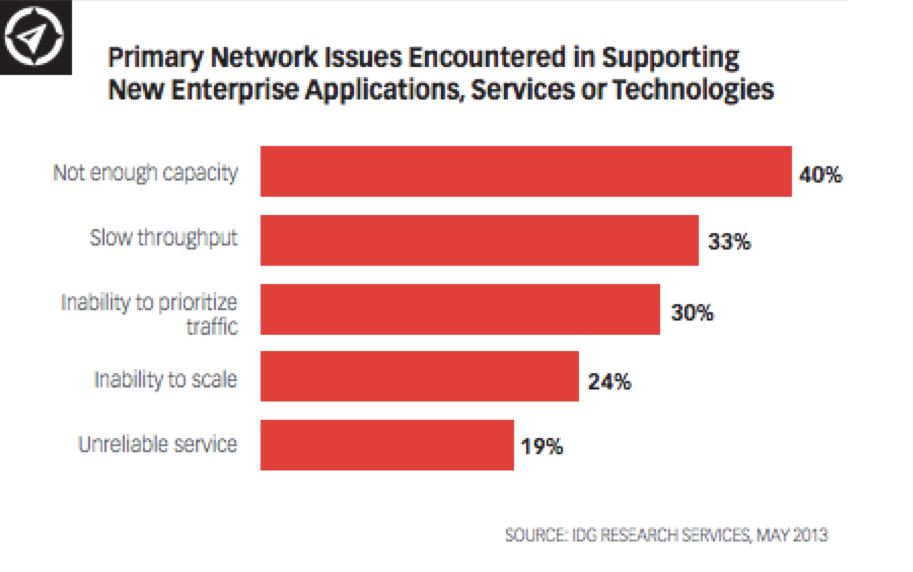The Network as a Business Growth Engine

Trends such as Big Data and BYOD have made the network more critical than ever. Research shows the pain points IT departments are experiencing with network infrastructure—and the investments they’re making to improve capacity, scalability and flexibility.
Like Rodney Dangerfield, the corporate network generally gets no respect. People talk about it only when it is down or performing poorly.
These perceptions, however, are beginning to change. Enterprise trends such as Bring Your Own Device (BYOD), mobility, Big Data and cloud computing have made the network more critical than ever in the eyes of both IT and business users.
There is little doubt that the increased demand for bandwidth resulting from these trends is putting a strain on corporate networks. The vast majority of respondents to an April, 2013 IDG Research Services survey say their corporate networks have run up against capacity, throughput and other issues related to new applications or services. And there is no sign of a letup: Half expect increases in data center traffic to put significant pressure on the network over the next 12 months.
“For many organizations, application demand has gone beyond what the network can support,” says Eric Wanzer, director of marketing operations and sales enablement, Comcast Business. “IT is realizing they can no longer wait to invest in the network because their business is demanding changes to the infrastructure.”
As a result, organizations are increasing investments in emerging network technologies such as Ethernet/fiber services, which provide the bandwidth and scalability they require to support increasing traffic and connected devices. Through these services, the modern IT organization can better position the network to deliver on two core elements of its mission: improving end-user productivity and unlocking new opportunities for business growth.
Emerging Technologies Put More Demand on the Network
IDC predicts that from 2005 to 2020, the digital universe— the data created, replicated and consumed in a single year—will grow by a factor of 300, from 130 exabytes to 40,000 exabytes . The rise of Big Data, combined with enterprise technology trends such as BYOD, virtualization, business continuity/disaster recovery and cloud services, continue to put a heavy burden on enterprise networks, according to new research from IDG Research Services.
More than eight in 10 respondents to the survey say that new enterprise applications, services or technologies have caused network-related issues such as insufficient capacity, slow throughput and an inability to prioritize traffic.

Data archiving is the biggest inhibitor to network performance, according to respondents, followed by rich media, image transfers and voice-over-IP services. Increased use of these types of high-bandwidth applications, combined with the growing repository of data that businesses are collecting from myriad devices, will push many corporate networks to the breaking point. Survey respondents expect significant pressure to be put on their networks over the next 12 months, citing increases in data center traffic, BYOD/mobility initiatives, business continuity/disaster recovery and virtualization as the primary contributors.
The pace at which new technologies are rolling out is so rapid that IT organizations often have difficulty gauging the impact until after these technologies are deployed. Nearly half the survey respondents (47 percent) say they sometimes invest in new applications, services or technology and later discover that their network does not have adequate bandwidth to support them. That poses a big challenge for businesses that increasingly rely on real-time access to information to fuel their growth engines, serve customers and stay one step ahead of competitors. “People want access to information,” Wanzer says. “The expectation is to have information everywhere. Availability is no longer nice to have for the end user—it’s a demand.”
Emphasizing Network Performance Drives Investment
Considering what is at stake, it is not surprising that 85 percent of IT decision-makers consider network connectivity to be a critical or very important enabler of strategic business goals, such as increasing efficiency or improving productivity. However, the challenge—exacerbated by the global financial crisis—has been getting the business to invest in the network upgrades necessary to achieve these goals.
The purse strings may be loosening a bit. The majority of survey respondents (61 percent) say their organizations will make moderate to significant investments in network services or fiber connectivity over the next 12 months, trailing only applications as an investment priority. Ethernet over fiber is becoming the WAN connectivity method of choice for the majority of organizations; 75 percent of respondents say they are currently using Ethernet/fiber and 62 percent say they plan to invest or increase investment in the technology over the next 24 months.

For many organizations, Ethernet/fiber connectivity is a logical next step in their migration from legacy T1 or ATM/frame relay connectivity services. The ability to manage private line, Internet and, increasingly, voice traffic over high-speed Ethernet connections is particularly appealing to IT teams looking to bring some order to the chaotic network infrastructures that have sprung up around them.
“The ability to provide bandwidth and capacity through a dynamic Ethernet topology gives IT a better option for centralizing infrastructure,” Wanzer says. “Looking across the entire enterprise, centralization of data centers, voice, video and Internet can provide huge gains in performance and efficiency. The beauty is in its simplicity.”
From Managing Costs to Driving Business Value
Investments in Ethernet/fiber and other high-capacity network connectivity are not simply a play for more bandwidth. Organizations are beginning to understand—and build a case around—the business benefits of a high-performance network. Better application performance, enabled by highly reliable, high-speed connections, can have a direct impact on areas such as end-user productivity, customer satisfaction and security.
“More organizations are seeing the benefits of managing one homogeneous network rather than a collection of point-to-point connections to remote offices,” Wanzer says. “If I can extend my Ethernet cable from the data center out to remote sites, I can start moving to a single solution that limits points of entry to improve security as well as performance.”

There is still room for improvement. While most respondents are pleased with current network
performance in critical areas such as reliability, security, throughput and bandwidth availability, a gap remains between the perceived importance of those areas and the network’s ability to deliver. For example, 92 percent rated network reliability as very important or critical, but just 78 percent say reliability was very good or excellent— a 14 percent difference in expectations versus performance.
Those who are investing exclusively in Ethernet/fiber, however, are more likely to rate their existing network services highly, especially in the areas of reliability and performance. Additionally, this segment is less likely to encounter network-related issues in supporting new enterprise applications, services or technologies (30 percent versus 47 percent).
Making a Business Case for Network Investment
CIOs and their IT teams understand that building a business case for network investment does not begin with a discussion about technology. Increasingly, IT organizations are working with other business stakeholders to determine the business need, and then identifying solutions to address the need.
“The applications are the story that enables IT to rethink the network,” Wanzer says. “Before you talk about the technology, talk about what you want to accomplish as a business over the next three to five years.” With those overarching goals in mind, CIOs should consider three key elements of any pitch for network investment:
- Business benefits: Focus the conversation on tangible benefits that a higher-capacity, reliable, low-latency and highly secure network can provide to employees, partners and customers. Faster access to information can improve end-user productivity, increase supply-chain efficiencies, enable faster decision-making and improve customer-facing channels such as call centers, websites and point-of-sale operations. The ability to scale capacity quickly during peak times means the network will perform when the business needs it most.
- Cost management: Integrating multiple data, voice and video services into a single high-capacity network, along with centralizing private line and Internet connections to remote offices, can drive down fixed costs as well as ongoing maintenance. Centralization can also help IT teams better manage the costs of services such as disaster recovery/business continuity.
- Resource reallocation: IT teams have been asked to do more with less for years. The efficiencies gained by integrating voice and data services across multiple sites via a high-capacity network can free up critical IT resources to focus on growth initiatives instead of just maintenance. “Because of the economy, a lot of businesses have been operating in a way that has burned out IT personnel,” Wanzer says. “Ultimately, the business suffers from that. A high-bandwidth solution that provides scale and flexibility can give the IT organization some relief to focus on the 30 other projects they have.”
Summary
The enterprise network, once the Rodney Dangerfield of IT, has emerged as a key enabler of business agility. Organizations that want to remain competitive in today’s fast-moving climate are paying more respect to the network and investing in technologies and services that enable better efficiency, productivity and performance across the entire business.
As the results of our IDG Research Services survey indicate, IT decision-makers are placing a higher value on network connectivity as a means to achieving business goals. In a dynamic environment in which employees and customers alike expect instant access to information, from any location and with any computing device, continued investment in network services that provide both scale and flexibility will be critical to a business’s ability to respond to real-time demands and create a foundation for sustainable growth.
Research shows the pain points IT departments are experiencing with network infrastructure—and the investments they’re making to improve capacity, scalability and flexibility.
Locked Content
Click on the button below to get access
Unlock NowOr sign in to access all content on Comcast Business Community
Learn how Comcast Business can help
keep you ready for what's next.











